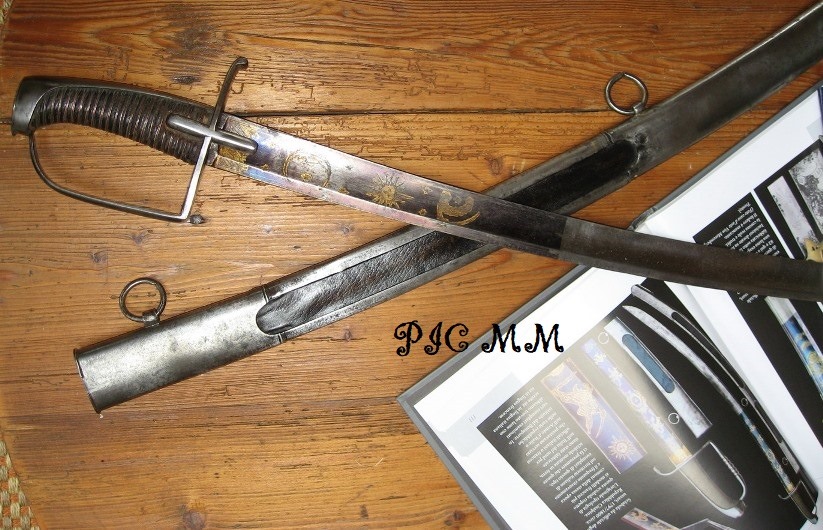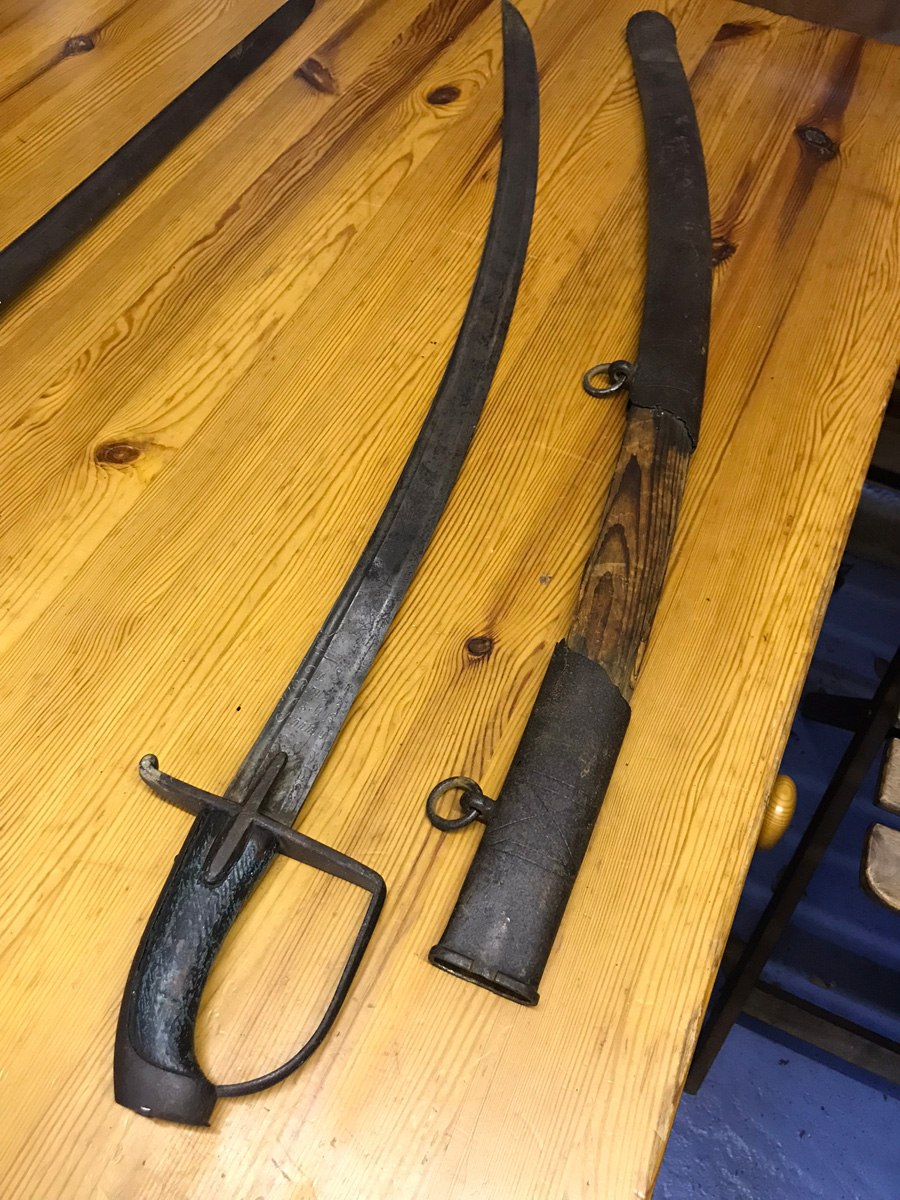Quote:
Originally Posted by Jim McDougall

As with most things, variation and exception are a constant, and with the Solingen situation, it was a manufacturing center for blades, which involved many makers, shops and artisans. Naturally there may have been cases of specific completed swords in which entire decorated blades were mounted there. However, this, in my opinion was one of the exceptions.
|
How do we qualify an exception? From the surviving examples, we know that Solingen made a vast quantity of blades. If ten percent of their business was completed swords, does this qualify as an exception? What evidence do we have to even speculate on such a percentage?
We know from the research and physical examples that J J Runkel imported into the UK completed swords into the UK; the 1788 pattern from my collection is one of those and a perfect example of a generic 1780s "Hussar" sabre, that would otherwise be labelled "European Hussar Sabre" were it not for the British Ordinance board stamp. The capacity to make those swords had to be in place for him to be able to supply them.

I can show you two other examples of near-identical swords made by Solingen that, were it not for markings, would be nearly impossible to identify accurately.


Quote:
Originally Posted by Jim McDougall

To the case in point, I dont believe that the decorative 'rose' images inscribed on the blade spines at the forte were ubiquitous enough in such blades which might have been applied in Solingen to designate them as a 'Solingen' affectation. In most of the cases by the examples shown, they seem to be aligned with French officers swords of 18th c into 19th along with armies associated with the French. As we agree, the blades on these were likely acquired by Caissagnard, and certainly other furbishers, for mounting.
|
I should point out that in the period they were used, France did control a significant proportion of Europe, inspired the fashion of Europe and filled her armies with men from European allies & vassal states.
Also, there is a huge element of selection bias in the examples I've shown. Since I have primarily focused my personal collecting research on French, British and where possible, Dutch swords. It is only natural that the database of images I have gathered and drawn from will heavily feature swords from these nations. I am sure there are plenty of examples from other nations that I have overlooked since they fall outside of my personal field of interest. With the collectors I have spoken to who share a similar field of interest, it is pretty much a given that the Rose is a Solingen mark, the questions are more around when it started, stopped and what they mean.
If you or anyone else has examples of blades with the Rose that can be positively identified as not having been produced in Solingen, I would be truly grateful.
Quote:
Originally Posted by Jim McDougall

If in some cases, these cutlers had found artisans in Solingen to apply particular decoration, this would not be surprising, however this would be an incidental case, and not supportive of these decorations being a collectively used decoration or certainly not a certain makers indicator from Solingen in specific.
|
I disagree, and the physical evidence demonstrates that a good portion of Solingen-made blades were sold pre-decorated. Furthermore, it is doubtful that many foreign cutlers dealt directly with the bladesmiths themselves, and instead went through intermediaries such as Runkel and S&K.
The two S&K blades I have shown earlier are pretty much identical in decorations, including the S&K logo on the ricasso. Since S&K were specifically traders, they would have purchased these blades with the decorations pre-applied for on-sale to the French cutlers. The smallsword in my collection with the blade from Johann & Clemens Boegel would have been sold with their I.C.B logo and decorations applied to the blade.
Of the twenty-two British swords in my collection, six of them have blades imported by Runkel, four of them have near identical decorations even though they were sold to four different cutlers (Prosser, Bennett, Archer of Dublin and one unknown). Of the two that have atypical decorations, the first is the 1788 that was imported as a complete sword and the second is a 1796 Pattern heavy cavalry officers dress sword. Of the 1796, these have a double-edged blade and the majority of the surviving examples have plain blades with Runkels' signature in the fuller.
When I look at a single-edged British sword, I can instantly spot that it carries a Runkel or Solingen blade purely by its decorations. Naturally, it is likely that bare Solingen blades were imported and then locally decorated in British fashion, but without a Solingen stamp on the blade there is no way to identify an example. Existing blades marked to Solingen with British decorations are rare in my experience.
Quote:
Originally Posted by Jim McDougall

So these decorative blade conventions traveled through Europe of course including cases in Solingen but most blades made there were simply marked with punzones. The famed 'running wolf' of Passau, began used on blades by contract to certain Passau armorers; the 'ANDREA FERARA' for blades primarily consigned to Scotland (many to England as well); the SAHAGUM (in variation) mostly to Northern Europe.
Many blades used spurious Spanish punzones along with marks intended for espaderos del Rey, incongruently which along with incorrect wording, spelling etc. belied the Solingen origins of these blades.
|
I believe that this style of marking (Andrea Ferara and Sahagum) had dropped out of favour by the late 18th Century; blades with these markings typically pre-date the 1760s. I also believe that the Passau wolf disappeared at the end of the 17th century, maybe in the early 18th.
The period that we're talking about, 1770 - 1820, is where we see an increase in the use of complex decorations such as talismanic symbols, etching and chemical blue and gilt finishing. This is the period where the Rose can be found and then disappears. Being able to pinpoint when it disappears helps us date swords better as well.
I agree that the fashion for talismanic symbols very likely came to Western Europe via the Hungarian hussars.
Quote:
Originally Posted by Jim McDougall

I am far from claiming metallurgical knowledge or metal processing, but the use of Indian steel (wootz) was indeed widespread, but not necessarily used as such in Viking swords.
|
I've only heard of one example but found it incredible so it stuck in my mind. Also remember that the Vikings were first and foremost traders and they travelled as far as the Mediterranean to trade. So using steel from India is not so far-fetched when we consider that Alexander the Great himself invaded India centuries earlier.
Quote:
Originally Posted by Jim McDougall

These are mostly just my understanding of various aspects of topics we are discussing, and as always, exchanging of these kinds of details give us a better perspective in reaching at least somewhat more comprehensive scope on them. This along with the remarkable examples being shown is outstanding!
|
Amen to that, we only learn through sharing.